#and leave behind a unique physical trace of their tangible existence
Text
i'm developing a moral and ethical code around my agnostic skepticism. i'm at the point where i have to Try The Thing I Don't Believe In not only for the ability to say that I tried but also to say that it definitely didn't work for me.
the truth of it all is that i legit desperately want to touch some proof of divinity or expanded consciousness etc etc if only to disprove an awful theory i've developed about the nature of reality myself.
#I'm Talking#i'm not going to say said theory#because it is legit coo coo bananas crazy#but your gods will have to appear before me#kiss me on the forehead#and leave behind a unique physical trace of their tangible existence#for me to believe in them#i'm at that point now lol
8 notes
·
View notes
Text
Reflection
Part of me is stuck in a mirror. A large, glistening, silver mirror hung in the light, sunny hall of a large Adam style mansion in Scotland. There is no getting out of the mirror. I became trapped somehow, but I can’t remember how it happened, just that it did. My tangible body can leave the mirror, but only at night. During the day, I spend my time serving as a reflection for those I can’t touch. Having your soul anchored to a mirror is not very fun so I make my own entertainment.
Sometimes I mangle the reflections of the occupants, grossly exaggerating their faults; other times, I simply point them out, hinting at things here and there. When I do distort their reflection, I enlarge or shrink their limbs, turning their eyes a stony black or misty orange. Perhaps I will show their nose and lips frosted with brilliant red flakes, or a scalp like a granite bald spotted with lesions and corkscrew curls slipping off onto the plush, carpeted floor. Other times I will bloat their heads, so they swell like a new blister, if they are especially full of themselves. This is only if I am in a bad mood or they are incessantly vain or spiteful.
Often though, I work with small hints; paling the mistress of the houses cheeks when she has forgotten her blush or showing a maid's laundry as filthy rags so she will glance into the basket and see there is a blotch upon the cloth. Sometimes I strip the master’s coat of its buttons, so he looks down and notices one is missing. My helpfulness has never been questioned by the inhabitants, for they are thankful, but it is not uncommon that a guest I do not like will come running from my hall babbling about a demon-possessed mirror. They are put off as having drunk too much, besides, I am not a demon but a stuck vampire.
Once, I was messing around and didn’t notice that the master’s son was standing in front of my mirror. I hadn’t even felt myself shift into his body, but I had conjured spiders in my ebony prison. The master’s son is almost deathly afraid of spiders, but he stood before me as if he was entranced. I froze, spiders still dangling from my fingers and crawling across my shoulders. He glanced at his own shoulders and fingers, finding nothing. Confused, he looked back to me. I continued to play with the spiders, letting them crawl across my knuckles like I was flipping coins like so many expert magicians do. The master’s son mimics my actions like he is the reflection instead.
I expect him to say something, or run away screaming; he doesn’t. After a few moments he pads away. Frowning, I feel myself shift back to whatever I was before he appeared. Minutes later he comes back, cradling one of the long, thin, limbed spiders that frequent the dusty corners of the house in his hand. He looks from the spider and then up to me. Then he breathes on the mirror, tracing his fingers in the fog. When he finishes his fading words spell out ‘I’m not afraid.” I suppose I helped him overcome his fear.
The master’s son comes back a few times after, but otherwise, I spend my days changing. My nights are much more fun, well for me at least. As soon as the sun goes down, my physical essence is released from the mirror, free to feed. I don’t dare try to feed upon my house. The occupants are too important because they protect me. Instead I flee to the surrounding villages and towns.
After I feed, I race back to my residence. I have a few hours before sun rise so I roam the house, searching for clues of how I became trapped. I wander the halls, my barely existent feet whispering across the carpet. I start in my hall, staring at my nonexistent reflection. I do not know what I look like since I never appear as myself. I don’t even know what people see when they look at me outside of my mirror.
Brushing away my self-consciousness, I start to stalk the shadowy halls and spacious rooms. I find no clues, I never have; I have no idea how long I have been dead, but I know I have been searching ever since the day I woke up on the other side of the glass. I remember banging my fists against the crystal, the pounding echoing through my prison along with my screams which never grew gravely like my voice would have if I were alive. If I hadn’t been undead.
I can still recall how badly I scared the one maid without meaning to. I don’t think she could hear my screams, but I could see my reflection in her eyes, my horrible, horrible reflection. My body was contorted in a horrifying way, my nails elongated, my mouth wrenched open like my jaw had been broken, my obsidian dark hair floating around my head like a devil’s halo, my skin as pale as the glass before me, and my clothes falling off of me like strips of bloodied flesh. The worst part was that I wore her face. She screamed and bolted. I never saw her again. After that, I learned how to control my transformation and I would always watch their eyes, trying to find my own face. I never did. It was always theirs.
I brush away my brooding thoughts, putting them in lockdown; no more depressing notions for tonight.
I decide to try something new. I search for the room of one of the master's daughters. I find her door cracked, a light spring breeze blowing through. I nudge open the large oak door with my foot, making sure the thick iron hinges don’t squeak. She lays in her bed, white sheets and furs piled on her body. I slip through her room, sticking to the shadows like the parasite I am, until I reach her mirror. It is a unique style; it looks nothing like mine. The glass is cloudy, and it rests in a simple wooden frame. I peer into it, trying to decipher my reflection from its murky projection. I see only a light silhouette framed by faded black locks.
No face looks back at me. It seems I only carry a bit of my soul and that little piece reflects nothing but a silhouette. I weep silently, my features still schooled into a practiced stare. I am a statue; nothing moves except the salty tears that drip from my cheeks, hang from my chin like icicles, and trace trails down my throat. I weep for my lost humanity, for the person I will never be, for that small bit of who I used to be. My tears are the only thing I can keep, and I spend them frivolously, wasting them on my pain and heartache.
I hear something shifting behind me. I swirl around, my loose clothing swirling with me, dark ribbons of crimson flashing through the air. The master’s daughter has sat up, blinking, and rubbing sleep from her eyes. Her eyes sweep over me, up and down my ruby clad figure. She gasps as we stare at each other. I don’t feel my flesh rippling, I’m not changing. She hops up, lighting a candle as she fumbles for something on her desk. I am afraid she will try to attack me with a stake or a rosary.
I back up, bumping into the icy, clouded, mirror. She whips around, the candle’s flame flickering through the air as it is buffeted by the spring zephyr. She is holding a tablet of paper and charcoal. Plopping on the floor, she begins sketching vigorously on the tablet. Her brow furrows and I find mine doing the same. I creep closer, trying not to spook her. I am the one that spooks, the one that freezes when she glances up and studies me. Then she glances back down and brushes the paper furiously with the charcoal.
Stalking closer, I examine what she is drawing, my head bent so close to hers that my dark hair brushes her blonde tresses. She’s drawing me! Fear fills me, I am not ready; after being a reflection my whole life, I am not ready to see my own despite wanting to for years. I flee from the room, my feet racing me back to my mirror. Shoving my hands onto the frigid glass, I am sucked back in. I curl in one of my stony corners and weep.
I sleep, something I don’t think I have done before. When I wake, I find something pressed against my mirror. It’s me. I stare at myself. I feel my muscles force themselves into a reflection, but it isn’t a reflection, it's me. It’s me before I died, it doesn’t matter that I am paler than I think I should be. I feel whole.
The master’s daughter stands behind the picture, her tanned hand pushing the paper to my mirror, with her brother at her side. I look at them and my face doesn’t change. I stay me and they see me. They smile at me, the daughter glancing over at her brother as he lifts his hand. In his palm, he cradles the same spider he had held the day he, no we, overcame his phobia. He smiles brighter and his sister looks at me. She nods and I answer it with a grateful smile. Two silent thank yous and two acknowledgements.
She pulls the paper away, kneels at the mirrors base and slides it into the same, simple wooden frame that once held her mirror. Standing back up and grasping her brothers' free hand, she hangs the picture across the hall where I can see. Nodding at me again, they pad down the hall. They helped me find myself, something I used to do for others. Grateful and satisfied, I return to my corner, which seems more kind than before. I nestle back in and sleep.
#short story#short story I wrote for my first college english class#supernatural#vampires#english literature
1 note
·
View note
Text
What our children’s art can teach us
All children love to draw and paint, but why do they do it and what can their creations tell us about them? Dr Helen Jones explores the meaning behind the art and explains how to help your child’s creativity flourish:
Table of contents:
Art is personal
Realism vs expression
Modes of expression
The cross disciplinary nature of art: how it teaches us about other subjects
Final word
Art is personal
At the very earliest stages of evolution our forebears were making art.
In 40,000 BC, creative symbolic artworks were being handcrafted from shell, stone, and primitive paint by homosapiens. But it begs the question: why?
Why has there been an enduring drive, spanning our entire existence, to leave marks, to make our trace in the world, to create?
It is one of the few things which distinguishes us from animals. We have this wonderful yet mysterious power to create distinctly personal and individual remnants of our existence and personality.
Art is a discipline that champions our individualism. It allows us to show and share our experiences of life, without hiding who we are.
‘As we have changed, our art has changed, and how we have defined our art has changed, but that fundamental instinct to play experiment, repurpose, test and reimagine has always been central. Just as play is a deliberate pushing of the boundaries, so art has refused to be solely defined by one idea or one set of people.’ (Michael Rosen.)
We’ve all heard ‘No one is you. That is your superpower.’ As an artist, and head of art, I’d argue that nowhere is this superpower more visible, than in our visual creations.
Art prizes the original. It prizes the unique.
It says if you don’t comply with a conventional norm, then good on you. I love telling children in my lessons, that in art there is no right answer or wrong answer.
Yet very often we can act, even subconsciously, as if there is. Forcing our children into a straightjacket of neat and realistic depictions of reality.
Parents will ask me why one child can draw so much better than theirs, when perhaps they should be asking why we assume that child’s style of drawing is better.
There is a deeply-entrenched tendency to measure children's drawing by its ‘lifelike’ standards. But as John Matthews suggests in Drawing and Painting: children and visual representation: ‘The idea that the representation of objects is at the heart of drawing is completely wrong.’
Art is a cacophony of ideas, expression and imagination. What would the world be like if it were all logical, realistic drawing? Salvador Dali, Picasso, Pollock, Hirst, not to mention thousands of other artists, would never have dazzled us with their unique ways of seeing.
Perhaps we need to consider representation as ‘re-presentation’. Because as Matthews asserts: ‘what is ‘realistic’ to the child changes with age and context.’ Perhaps it is important to your child to draw you as a humongous, overly tall figure, because to them, you seem much bigger. Thus our adult definition of art doesn’t always align with our child’s way of seeing the world.
What’s more, there are many more forms of drawing than we often realise. Drawing through stitch, drawing in sand, drawing with a sparkler, drawing with wire and so on. Contemporary artists make drawings in all sorts of ways, in non traditional media, with unconventional tools. This allows them to express things they couldn’t have in any other way.
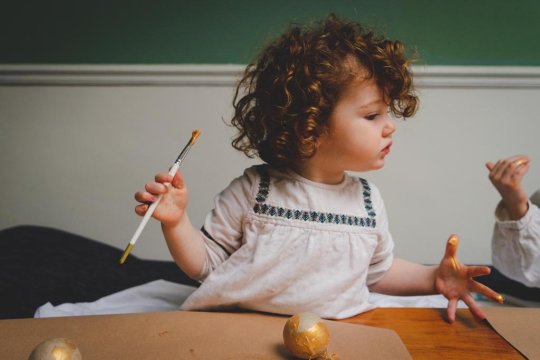
Realism vs. expression
Simply forcing children to draw from life doesn’t aid artistic expression. We need our children to communicate what they are thinking, imagining and feeling in many languages, verbal, spatial, gestural, musical and visual. We want them to embark on a ‘representational adventure in which meanings are given sounds, actions and images.’ John Matthews
I tell my art students ‘a camera is for capturing a realistic copy of the world around you. Art is for capturing your interpretation of the world and for expressing your unique individuality’. Often this falls on deaf ears, so prevalent are beliefs about the hierarchy of representational depiction. But what is realistic? How do things look really? Unfortunately our fixed assumptions to these questions can, at best, hinder learning possibilities, or at worst, damage our children’s self-efficacy[LINK]. So often children have fallen prey to adults working from a deficit theory - looking for what’s ‘wrong’ or ‘missing’ from their artworks. This can really corrode a child’s confidence, but more than that, it’s not necessarily right.
We unconsciously place realism at the top of the ladder, and all the other steps below it are often relegated as scribbles or ‘nearly corrects’. As children climb this ladder, (often in standardised educational settings), they get less and less opportunity to draw freely. Spontaneous drawing which serves the intentions and interests of children is becoming increasingly hard to find in schools. According to Matthews, this is detrimental to children’s emotional and intellectual development, ‘The child's own spontaneous visual representation and expression has been devalued in favour of a fixed, acceptable, cultural standard’
So how can we avoid this?
Perhaps we should spend more time listening to what their drawings tell us. Just as we as adults use hand gestures, facial expressions, tone range and movements as we talk, children use these features in their artwork. For instance, mark making can represent experiences of hide and seek, people leaving us and coming back into our lives, movement, such as going through tunnels, hiding underneath something, the feel and motion of swimming, and, importantly, it can reconcile traumatic encounters. Art is a processing of these happenings, through thoughtful gesture and mark making, which is quite different than mere representation. Thus the ‘re-presenting’ might not look like what the child is responding to, but what is occurring is a significant translation of that event.
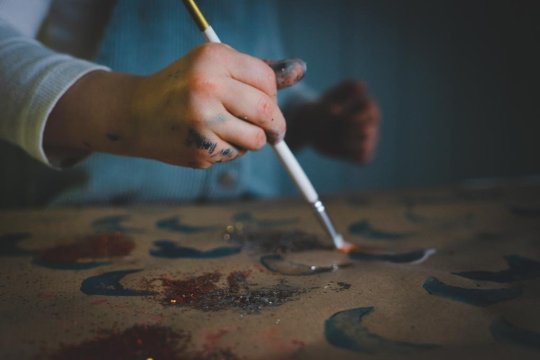
Modes of expression
Children capture different types of information, often following different intentions or modes of thinking in their work, some of which I have simplified for ease of understanding.
Intellectual realism.
Sometimes children draw unrecognisable shapes and claim they are a certain person or object. While this may not be realism in the sense we know it, it could be ‘intellectual realism’ in that for the child it represents their internalised view of that object or person. It shows what the child knows, rather than what the child sees.
Symbolism and representation.
The vast majority of learning is based on signs and symbols, such as language and maths for instance, and even social interaction. Drawing is an idealised way to grasp this nature of symbolism. Discovering that marks on paper can stand for things turns a cornerstone in one's mind - a huge developmental shift.
Emotional.
Art and feelings go hand in hand. Matthews says: ‘Children’s drawing actions are sensitive to fluctuations in mood, both their own and those of people around them. The child imbues drawing with emotion and representational possibilities.’ Perhaps this is why art therapy is so successful - emotions are made tangible as they are inflected on the surface of the paper and the surface of their minds.
Grouping.
Children might group together different types of marks such as dots or dashes or marks at the beginning or end of these lines - separating out their shape vocabulary and becoming adept at matching their actions to shapes. By grouping marks according to type, he is beginning a process of classification. This is the start of maths.
Art as play.
Art can be nothing short of imaginative play. Sometimes there is no intention, other than sheer joy and exploration. I often see children use three-dimensional objects and toys in a similar way to how they use drawing - reconstructing comparable scenes and dealing with related issues. This shows that mark making is tethered to all of our experiences, especially play which has creative overlaps.
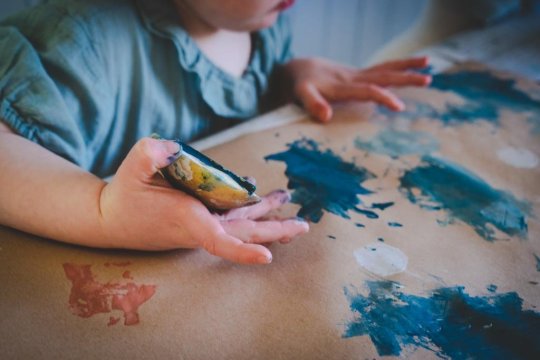
The cross disciplinary nature of art: How it teaches us about other subjects
If we listen to our body closely enough we know what it needs. I also believe if we listen to our mind closely enough we know what it needs. And children are no exception, in that they subconsciously know what they need to learn.
‘The child is constantly, actively, purposely, seeking out those particular experiences which will promote growth.’ John Matthews
Children are always in pursuit of learning, whether they realise it or not. For me, nowhere is this more visible than in their art. It makes their learning observable, and holds the power to teach a range of subjects and disciplines, and to make them fun.
Music and sound.
Listen to your child as they are drawing - what sounds do they make? I’ve seen children blend sounds and drawings together time and time again. My daughter's experiences with music - the tempo, beat, and patterns within the song - form a backdrop to the patterns and pulsating lines she produces.
Body awareness.
‘Proprioceptive’ information about the position of our joints and limbs, balance, posture and stance are heightened in art making. When making with our hands we learn how things move, how our body moves, and how shapes can be coordinated and controlled in a dynamic, swiftly changing format. Although I would argue that not only does art make us more aware of our physical selves, it helps us reveal our inner souls.
Mathematical.
The American professor of maths John De Pillis writes: ‘‘When learners have the opportunity to use their artistic skills and draw scenarios, they can more easily visualize and figure out math problems.’ Angles, geometric shapes, measuring, proportions, ratios of paint to water, scale and perspective are some of the mathematical gifts of art.
Linguistic learning.
Art is a visual language. A universal language, that anyone can speak. We all recognise certain shapes and symbols and know what they represent. Learning the language or art support language learning in all other areas. Being able to speak visually goes hand in hand with general communication.
Science.
Children can grasp some quite unfathomable scientific concepts in their art. For example, by attempting to represent invisible events like wind, music, suction, or showing clouds moving, rain coming down, spilling from a cup, or documenting movement trajectories. They learn how to organise space, time, patterns and sequences of movement which share characteristics with what they see in the outside world. They can translate experiences of crawling through tunnels, pouring liquid through tubes, looking through cardboard rolls, into their art. Children explore and rationalise all this through drawing.
Perspective.
In more sense than one. Children can gain mental perspective on the bigger picture in life, on personal issues and dealing with trauma, as well as exploring physical perspective. As you draw ideas occur, whether that’s how to deal with or respond to a certain situation, or logical constraints such as how things get bigger towards you, and smaller further away. This shouldn’t make sense in the minds of our little young ones, but through art it does.
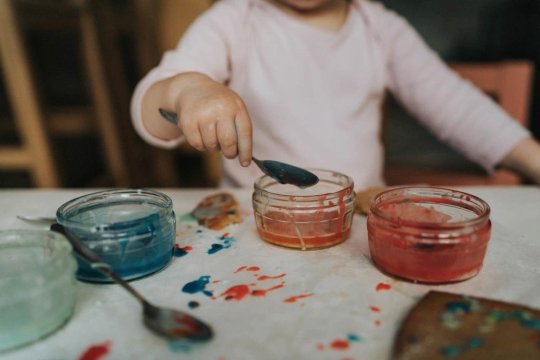
Final word
Perhaps we need to ask ourselves what we believe is the major endpoint in drawing or painting. And not just to consider the destination but the journey. Realistic drawing is one way of approaching art in a multitude of possibilities. So let’s stop looking for it as a ‘what’s missing’ from our children's art and encourage some freedom of expression for all.
When I consider my daughter's mark making, I can see that each image is saturated with communication, thinking and emotion. And that, for me, is far more valuable than a ‘picture perfect’ outcome.
from One Hundred Toys - The Blog https://ift.tt/3lXERpP
0 notes
Text
Outer Wilds and the Beauty of Emergent Gameplay Design
February 4, 2020 10:00 AM EST
Sometimes, discovering what your objective is can be your objective in and of itself, which makes the gameplay of Outer Wilds so compelling.
Editor’s Note: mild spoilers for Outer Wilds concepts are present in this editorial. Specific details and plot elements are kept as vague as possible, but but this is a game best experienced blind. Exercise caution before reading, but do play the game first and come back to this editorial after. It’s worth your time.
Had I played Outer Wilds in 2019, it would inevitably have been in my recent Top 10 list. A safe estimate would probably be that it would be #4, since it didn’t impact me quite as much as Disco Elysium, but I digress. What I’m saying is that Outer Wilds is an excellent video game, and I’m glad that I got the chance to tackle it recently.
youtube
Now, I would absolutely like to spend the rest of this article gushing about specific parts of Outer Wilds that I liked, including hugely interesting moments or revelations…but I won’t. Much of the charm and fascination that I had with Outer Wilds came from solving its mysteries entirely on my own. It might not be like that for others, but figuring things out entirely from a smattering of clues or acting on unspoken cues was a huge highlight for me.
You begin Outer Wilds by waking up on your home planet of Timber Hearth, staring up at the stars. You’re about to launch on your first space flight, and the opening section serves as a tutorial for many elements of the game you’ll come to experience. One big story beat happens, and then you will launch into space. At this point, freedom is yours! Anywhere you’d like to go in the solar system is completely open to you, once you’ve come to grips with the flight systems. You’ll never get any more tools or permanent upgrades beyond what you start with: the Scout Launcher, Signalscope, jetpack, and your spaceship.
The NPCs will offer a couple of basic suggestions: take a practice trip to the nearby moon? Or perhaps you’d like to meet up with the other explorers from Timber Hearth for tips and advice? The choice of actions you take is yours…up until the Sun promptly goes supernova after 22 minutes, ending all life in the solar system. Yes, that includes yours. After that, you begin once again on Timber Hearth, waking up and staring at the stars. Your ship computer carries over any points of interest or notes that you discovered, but that’s it. Time to do it again…and again…until you start figuring out what is happening and if this abrupt ending to the universe could possibly be prevented.
A Riddle, Wrapped in a Mystery, Inside an Enigma
What follows for the duration of Outer Wilds is a rhythm of learning the workings of the solar system. Each planet offers a set of unique challenges, and solving them will reveal more parts of a bigger mystery. A precursor race left behind traces of many interlinked science projects, and their notes will frequently reference other places or experiments taking place on wholly different planets.
It struck me fairly early on that the only thing I was doing to progress was simply furthering my understanding of the game’s mechanics and setting. This is hardly a unique case, but Outer Wilds is extremely hands-off in letting the player solve this system-sized puzzle. You can’t make the puzzles easier by upgrading your jetpack or oxygen tanks. Ship upgrades to withstand hazards don’t exist. There’s no weapons, and any hazards you find just have to be navigated around.
From beginning to end, I was driving the entire experience forward. A mystery laid before me, expertly crafted and divided into several different information clusters that organically flowed between each other. It became a massive web of science fiction intrigue, and I just had to keep going and see it through to the end. There was always that timer in the back of my mind, yet death by supernova or other hazard was but an inconvenience…and other times, a hasty reset was exactly what I needed to catch a window of opportunity.
A single loop was rarely the same. Sometimes I’d try to act on a hint I’d picked up along the way, only to be missing something crucial to aid my understanding. I’d hurtle into the side of cliffs by accident, park my ship in a place that saw it ejected into space without me, or overestimated distances and run out of oxygen in a cave somewhere. Perhaps I’d uncover a clue about a timed event that would happen ten minutes earlier in a loop, so I’d close out the remaining time by attempting to jetpack to the next planet over. Sometimes, the music would start to signal the end of the loop, and I’d just wait it out by watching the end.
And in some loops…I’d just explore, or try different things without aim. How close could I skirt to the sun to gravity slingshot away? How far out of the system could I make it? Outer Wilds would sometimes possess the atmosphere of a horror game, leaving me tense as I raced against the clock to accomplish some objective I had set. But on other loops I was far more relaxed, just taking in the environment or experimenting with the mechanics further. Having the fear of death and significant consequences removed was relaxing; I could just enjoy and find the unspoken objectives at my own leisurely pace.
Closing the Loop
There is an ending to Outer Wilds, mind you. The mystery does eventually unfold, and a conclusion is reached. I overcame one final loop, fraught with danger and even the threat of permanent consequences this time around. But eventually, all the puzzle pieces were in place, I watched the ending, and I was able to roast a marshmallow one more time before the credits rolled. The sensation was…bittersweet. Finishing the game was an accomplishment, and I’m proud that I managed to reach it. But there’s a pervasive knowledge now that will forever color any attempts that I have to play Outer Wilds again. You can never go back to the first time…we can never experience those same sensations again.
The pervading knowledge is mechanical, also. All the tools and trinkets available from the start will carry you through to the end; what changes is simply the understanding of what you can accomplish with them. Some clues are less about the game’s core mystery, and more hints as to entire laws of physics. One simple sentence in the game — which I won’t spoil — absolutely blew my mind once I processed the practical implications. Subsequent “Ah-hah!” moments of the game felt like major triumphs the likes of which I so rarely experience in games nowadays.
This brings us neatly to the core element of what works so well in Outer Wilds: emergent gameplay design. At no point did the game do anything more than nudge me out into the solar system. I could go anywhere, do anything, and act purely on self-motivation and curiosity. Everything I needed was right in front of me from the outset, but my willingness to play with the systems and explore lead to massive revelations and ramifications. Even stumbling through the tutorial has a looseness to its structure. Hell, revisiting that opening section later in the game made me really just how many future clues had been hinted at there, hiding in plain sight.
I play a significant amount of RPGs; grinding experience, gathering stronger equipment, and attaining incremental upgrades to overall power is familiar territory to me. There’s objectives to complete, requests to answer, rewards to attain, achievements to grind…as much as I quite enjoy these gameplay loops, it can truly start to become a little too structured. Some games end up feeling too much like busywork and maintenance.
“You can never go back to the first time…we can never experience those same sensations again.”
But without that kind of gameplay hook, many players might feel lost or overwhelmed. What’s our next step? What must we do from here? If I can’t best this challenge, what can I do to ease future attempts? Abandoning these essential questions and leaving it up to the player to craft answers is a bold move. It’s to the absolute credit of Mobius Digital that Outer Wilds managed to pull this off with such aplomb. The preservation of the ship log, the marker within if there’s a remaining clue, and a handful of audio cues are all the guidance you’ll be receiving. There’s no mechanical benefit to completing anything; your reward is writing to read, and knowledge for future loops.
Even games of an exploratory, free-form nature tend to fall back on markers and progression systems. Minecraft has a progression system through various equipment tiers, assuming you don’t just take to Creative Mode and build things. Breath of the Wild is large and rewards exploration with unique vistas, but also tangible rewards of shrines or Korok seeds.
Unspoken Player Guidance
Strangely, the game that I most liken to Outer Wilds is Super Metroid. Landing on planet Zebes in Super Metroid, Samus is isolated. The atmosphere is oppressive, despite your weapons and abilities. But the opening sections of the game are a masterclass of game design. Super Metroid subtly guides the player to their first handful of upgrades, encouraging them to figure out what they can do with subtle prompts, and then set the tone and stakes as its once dead world starts to come alive around you.
From landing on the planet to the first boss, the only instruction or line of text given is how to swap weapons to missiles. Everything else is inferred by the player as they descend and then return from that quick expedition. This trend holds throughout all of Super Metroid, keeping guidance and lessons vague as you navigate the planet. But always, there’s cues in how the levels are designed or laid out that encourage you onward. Even the most advanced concepts like wall jumps and Shinesparking is conferred not by text, but by seeing friendly creatures do something similar, and then mimicking their actions.
It’s this kind of non-vocal discovery and guidance that both Outer Wilds and Super Metroid excel at. Laying out a world and systems at the player’s feet, the onus is on you to explore it. Objectives must be uncovered first, and then achieved. Allowing the player to come to grips with gameplay systems, but not explicitly telling them? That creates massively impactful moments once they’re discovered. This subtle, unspoken game design is far more difficult to accomplish, but the fact that Outer Wilds managed it continues to impress.
“Subtle, unspoken game design is far more difficult to accomplish, but the fact that Outer Wilds managed it continues to impress.”
Now, I don’t intend to conclude this write-up by saying that all direction or explicit instruction in games is bad. I like RPGs too much to champion eschewing all progression systems. Nonetheless, Outer Wilds took a chance with its design: here’s a ship and basic tools, now go forth into this solar system! Live, die, repeat, over and over and over again…no progression systems, checklists, or clearly delineated objectives; just a solar system filled with curiosities and a mystery at the centre of it. Knowledge and understanding is all you’ll take with you on your next attempt, and it’s all you truly need to make it through.
Player-driven emergent design is a rare thing to behold in a game as well-curated and constructed as Outer Wilds. I didn’t expect to love it as much as I did, yet I’ve only come to appreciate it more as I wrote this. Once I watched the recent Noclip documentary on the game’s development, I was even more impressed with the design principles that went into it. Games that demand your time and constant attention are increasingly prevalent, so something hands-off and indirect was a breath of fresh air that I didn’t know I’d need. Any confusion generated by Obsidian’s similarly-titled game are unfortunate, but Outer Wilds is surely worth your time for a player-driven experience. Also, you should go play Super Metroid. It’s real good.
February 4, 2020 10:00 AM EST
from EnterGamingXP https://entergamingxp.com/2020/02/outer-wilds-and-the-beauty-of-emergent-gameplay-design/?utm_source=rss&utm_medium=rss&utm_campaign=outer-wilds-and-the-beauty-of-emergent-gameplay-design
0 notes
Text
Week 9 - Forum Responses
To Sean Poon in [Objects,] Talk to Me:
Hey Sean, love the Housekeeping quote – one of my favourite novels.
“Why must we be left, the survivors picking among the flotsam, among the small, unnoticed, unvalued clutter that was all that remained when they vanished, that only catastrophe made notable?” – Marilynne Robinson, Housekeeping
I like the grounding of your work in a local context, and it's great that you mention Rem Koolhaas; you might want to draw upon his essay, Singapore Songlines: Portrait of a Potemkin Metropolis… or 30 Years of Tabula Rasa, which expounds on themes that could be interwoven with what you propose. He speaks of Singapore as being built up from blank slate, with landmarks and histories erased, whole communities uprooted and moved for the construction of a pristine, generic, artificial, and regulated First World city. I imagine some historical parallels may be drawn to the hidden demographics of which you speak – what communities are written over in the palimpsest of state-sanctioned narratives? What are the "hidden transcripts" that may emerge from our engagement with these communities and histories? Singapore is not a mere "Potemkin city", as Koolhaas may have written.
A summary of the essay may be found here http://www.qlrs.com/essay.asp?id=805
While your work centres on the idea of certain objects as being replete with significance vis-à-vis contestation of space, I do feel like space and architecture are particularly salient themes in what you propose – I'm thinking of local artist Debbie Ding's work, Rules for the Expression of Architectural Desires, which is a collection of speculative rules and schemes for the urban design of a city, accompanied by a video work. It considers our relationship to built urban environments; how its supposed materiality manifests in entirely immaterial concepts and urban experiences. It might be interesting to juxtapose these themes with the experience of the hidden demographics you mention.
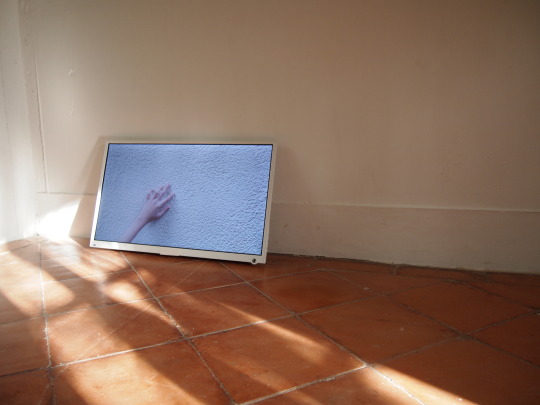
Debbie Ding's Architectural Desires (2015)
[Image source: http://dbbd.sg/works/architectural-desires.php]
The video work may be viewed at https://youtu.be/d59H6uIE0sM
Hopefully the works I recommend aren't too tangential and are at least of some interest to you. All the best for your project – sounds really promising.
To Geraldine Gan in Digital Marketing / Cyberbullying / Digital Interior Design:
Hey Geraldine -- I find your desire to combine concepts of marketing and recycling a unique synthesis. I see lots of potential for an artwork dealing with themes of environmentalism -- local artist Ong Kian Peng's Too Far, Too Near deals with the issue of climate change by creating an immersive space within which a viewer may contemplate global warming. A 2-channel video displays the image of melting glaciers, while electronic components and metal structures with metal balls slowly tilt and create subtle noises reminiscent of ice shifting and dissipating.
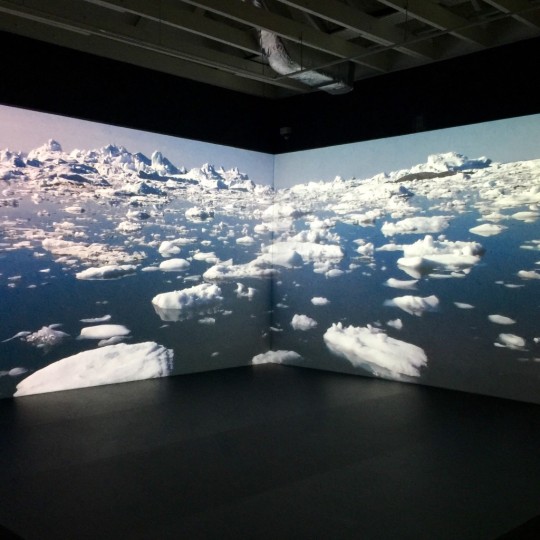
Ong Kian Peng, Too Far, Too Near, 2015, DC Motor, Metal balls, Steel structure; 2-channel video with 3-channel sound, Dimensions variable, Duration: 15 mins. [Image source: http://www.artitute.com/2015/09/27/singapore-got-art-talent-a-closer-look-at-the-2015-edition-of-the-presidents-young-talent/]
Perhaps this may give you an idea of how to go about creating spatiality even with two-dimensional videos, as Jacquelyn has raised as a point -- tapping on electronics and digital mediums to manipulate space and sense.
The idea of marketing can perhaps be linked to greater themes of capitalism and consumption -- though such are concepts often seen counter to environmentalism. I recommend the book This Changes Everything: Capitalism vs. the Climate by Naomi Klein, which touches upon the idea that the power of corporations (fueled by capitalism) prevents serious reforms to stop climate change and protect the environment.
To Aloysius Kow in Our everyday society:
Hey Aloysius -- interesting that you're applying the concept of surrealism to contemporary contexts and narratives. Here are some local artists that have dealt or drawn upon the iconography of everyday local scenes and abstracted them into something surreal or absurd.
Local artist Dorcas Ng's work, Commoners, was inspired by looking up at HDB buildings at night -- the lights and silhouettes from each unit suggesting a presence and an entire narrative we are not privy to. To elicit this same sense of curiousity and wonder borne from observation of everyday space, she created three box-like sculptures with electronic elements such as flashing lights or kinetic mechanisms, creating surreal, dreamlike re-imaginings of the HDB space. They are displayed in a specific manner: hung up high near the ceiling, such that guests must peer into each surreal HDB space from below, recreating the idea that we are catching a glimpse into lives different from our own. Ordinary becomes dream space, with each sculpture accompanied by a peculiar narrative written by the artist --
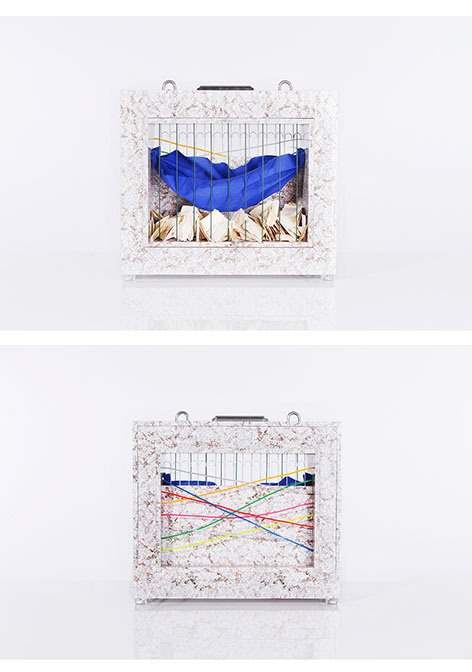
[Image source: http://www.aheeoee.info/COMMONERS]
Commoner A
Wood, metal, fabric, electronics
2015
"Commoner A wants to enter the lucid dream state in a quicker time. He decides on a hammock as a representational medium to transcend states of consciousness. Plus he is in deep need of active inspiration due to the nature of his job (without the need for drugs). 'One needs to constantly work hard at being creative.'"

[Image source: http://www.aheeoee.info/COMMONERS]
Commoner B
Wood, metal, fabric, electronics
2015
"Commoner B is moving out, albeit secretly. Large careless movements will alert the big-mouthed neighbours and chaos will ensue. The laundry should act as a good cover for all this commotion. 'Rain or shine, leave the laundry out.'"
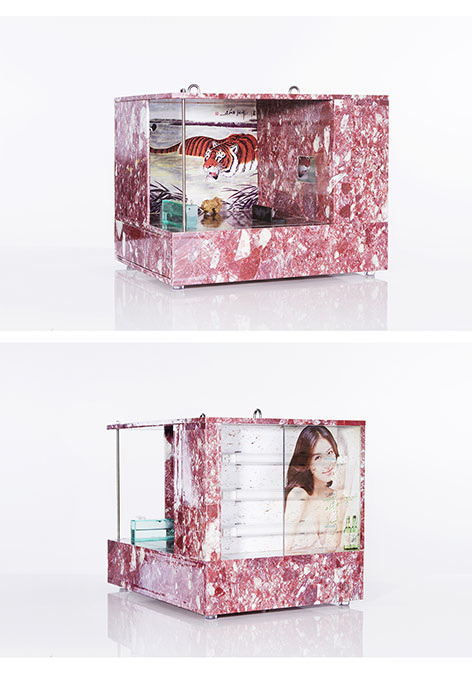
[Image source: http://www.aheeoee.info/COMMONERS]
Commoner D
Wood, metal, stone, electronics
2015
"With a ceiling high mural of a Chinese tiger in the living room you can kind of imagine the ferocity and desires of Commoner D. Living behind a billboard doesn't make his life easy in fact his speech and behaviour have to be carefully planned to avoid being caught. 'No traces should be lying around not even in my habitat.'"
As such, her works demonstrate an engagement with contemporary local images (the HDB) along with stories (imagined narratives of heartlanders).
Another work playing with the iconography of everyday objects and scenes from a local context is Kray Chen's Waiting on a Bird, which is a sculpture and video work reminiscent of a mahjong game -- except all four players are waiting for the same single tile which is nowhere to be found but on the television screen before them, a game that is impossible to win. Again, the everyday is taken and transformed into an absurd, surreal situation.
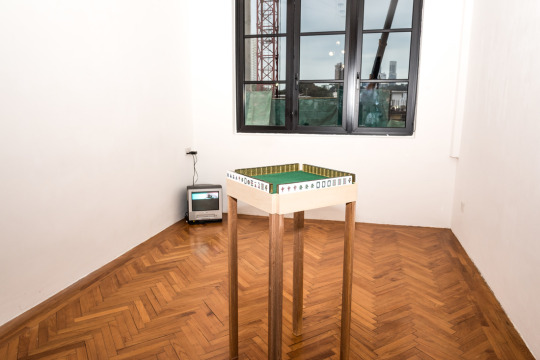
[Image source: http://www.kraychen.com/fortune-by-chance.html]
I suppose these artworks would guide how I would approach creating an artwork regarding the context of contemporary Singapore society -- taking images or situations that have significance to us and abstracting or distorting them to create a surreal situation that invites viewers to pause and ponder. These works can then be the entry point to several narratives, whether subtle or embedded within the artwork itself.
Hope these references give some ideas! Do check out more works by local artists, I imagine a lot of the themes they deal with are particularly salient to our lives.
Individual Forum Post
““[W]e’re suffering from brain fade. […] The flow is constant, […] Words, pictures, numbers, facts, graphics, statistics, specks, waves, particles, motes.” - Don Delillo, White Noise
I am interested in the idea of informational saturation as brought about by digital culture -- emerging from a desire to pay homage to the concept of brain fade as outlined within Don Delillo's novel, White Noise. Satirising consumer culture, one aspect of the novel is the constant barrage of information faced by the modern individual vis-à-vis mass communication. A continual sense of anxiety, along with the overall impotency of the modern individual in coping with this saturation is frighteningly well expressed. One can only extrapolate the extent to which these feelings may have grown with the advent of new media. Building upon these concepts explored in task 1, I wish to step beyond the concept of individual identity as affected and effected by these flows of information and wish to examine them within the greater general context of Singapore.
I am particularly interested in the idea of communities existing within these flows of information -- as imagined explorers, the sea people of an informational age, attempting to navigate tides of information. This plays upon the Manuel Castells' concepts of the space of flows, wherein physical space is seen as site for physical infrastructure allowing for metaphysical informational mobility -- here, playfully reimagined are these informational "flows" as something far more tangible and elemental; as if traversing oceanscapes.
This is inspired by Hito Steyerl's work, Liquidity Inc., wherein themes of capitalism and financial flows are expressed through the metaphor of water. The reimagining of human constructs such as markets, information, and data as manifest in a natural form such as water is an interesting, if absurd exercise.
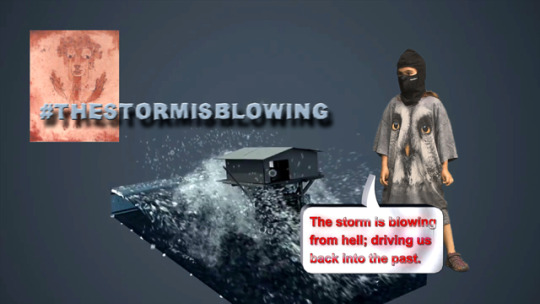
Hito Steyerl, still from ‘Liquidity Inc.’ (2014). Image source: http://www.aqnb.com/2014/03/05/hito-steyerl-the-ica-liquidity-inc/
The artwork I hope to develop will be an attempt at abstracting and distorting these informational flows and saturation, demonstrating the desperate attempt to integrate these flows into a bearable form of existence. Perhaps we can ask ourselves what are the ways in which we cope -- or fail to cope -- or do not need to cope -- with the constant flows of information we receive on a daily basis, and how these experiences can be expressed in an abstracted form.
0 notes